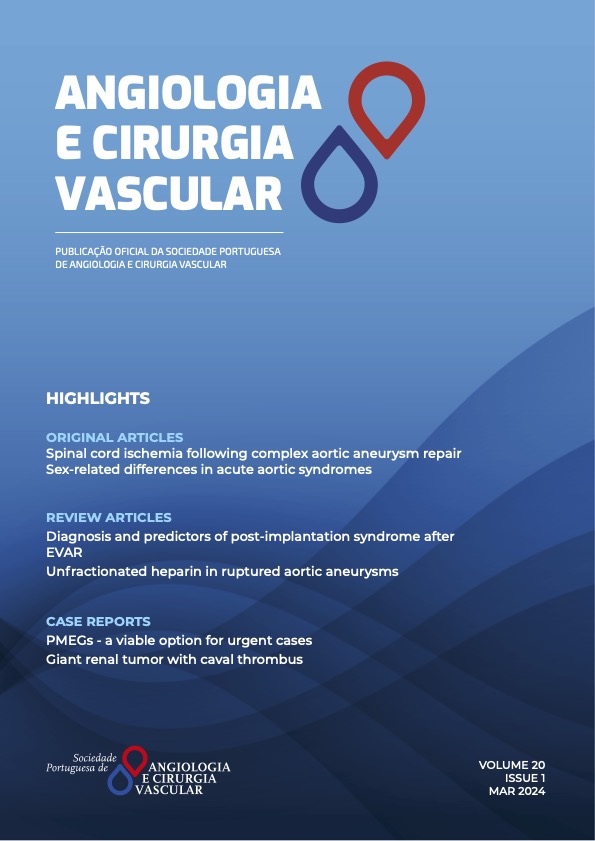Sex-related differences in patients with acute aortic syndromes
DOI:
https://doi.org/10.48750/acv.575Keywords:
Aortic syndromes, type B aortic dissection, sex differences, gender differences, in-hospital mortalityAbstract
INTRODUCTION: Heterogeneity in the epidemiology, management, and in-hospital outcomes of patients with acute aortic syndromes can be found among male and female populations. This study aims to analyze sex-related differences in a cohort of patients treated in a tertiary university center.METHODS: All patients admitted with acute aortic syndromes between January 2012 and January 2023 were retrospectively analyzed. A descriptive analysis of the data was performed, and the results were queried to explore sex-related differences according to the type of aortic syndrome, type of treatment (medical or surgical – conventional or endovascular), and the temporal phase of the disease in which this treatment occurred. A multivariable logistic regression was undertaken to identify variables associated with higher in-hospital mortality. Variables were included if statistically significant in the univariable analysis or if considered medically relevant.
RESULTS: A total of 116 patients (69% male) were included. Women were older (median age [interquartile range]: 64.6 years [40–85 years], n=36 versus 58.7 [23–84], n=80; P=0.034), had a higher proportion of intramural hematoma (19.4% versus 5.0%, P=0.014) and a lower proportion of aortic dissection (72.2% versus 88.8%, P=0.026) compared to men. Both sexes were more frequently treated with medical therapy alone (33.6%). However, women had a trend towards a lower proportion of open surgical management compared to men (16.7% versus 23.8%, P=0.391), as well as higher in-hospital mortality associated with this type of treatment (50.0% versus 21.1%, P=0.169). Additionally, women were associated with a higher conversion to endovascular or open surgery when first managed conservatively (13.9% versus 3.8%, P=0.046). In binary logistic regression, age was associated with higher in-hospital mortality (OR 1.056 [95% CI, 1.01-1.10]; P=0.014), but not female sex (OR 1.133 [95% CI, 0.39-3.30]; P=0.819).
CONCLUSION: Women were older, had more intramural hematoma, and were associated with a higher conversion from medical to surgical treatment. After multivariable regression, age was associated with higher in-hospital mortality, but female sex was not. Larger cohorts are needed to understand if intervention in female patients will have an impact on intra-hospital mortality.
Downloads
References
Erbel R, Aboyans V, Boileau C, Bossone E, Bartolomeo RD, Eggebrecht H, et al. ESC Guidelines on the diagnosis and treatment of aortic diseases: document covering acute and chronic aortic diseases of the thoracic and abdominal aorta of the adult. The Task Force for the Diagnosis and Treatment of Aortic Diseases of the European Society of Cardiology (ESC). Eur Heart J 2014;35:2873–926.
Bossone E, Carbone A, Eagle A. Gender Differences in Acute Aortic Dissection. J. Pers. Med. 2022;12:1148.
Frederike M, Arjen L, Carlijn T, Mostafa M, Jos B, Roland K, et al. Male– female differences in acute thoracic aortic dissection: a systematic review and meta-analysis. Interactive Cardiovasc Thor Surg 2022;34: 616–27.
Toshiyuki T, Hideaki Y, Koichi A, Tomoki S, Hitoshi O, Takashi K, et al. Sex-Related Differences in Clinical Features and In-Hospital Outcomes of Type B Acute Aortic Dissection: A Registry Study. J Am Heart Assoc 2022;11:e024149.
Liang L, Genovese A, Al-Khoury E, Hager S, Makaroun S, Singh J. Effects of Gender Differences on Short-Term Outcomes in Patients with Type B Aortic Dissection. Ann Vasc Surg 2017;38:78–83.
Maitusong B, Sun P, Xielifu D, Mahemuti M, Ma X, Liu F, et al. Sex-Related Differences Between Patients with Symptomatic Acute Aortic Dissection. Medicine 2016;95:e3100.
Liu J, Wang Z, Wang Y, He X, Yang L, Jing M, et al. Correlation between Sex and Prognosis of Acute Aortic Dissection in the Chinese Population. Chin Med J 2018;131:1430–5
Arturo E, Eric I, Eduardo B, Thomas G, Marco E, Udo S, et al. Insights From the International Registry of Acute Aortic Dissection 2018;137:1846-60
Hagan PG, Nienaber CA, Isselbacher EM, Bruckman D, Karavite DJ, Russman PL , et al. The International Registry of Acute Aortic Dissection (IRAD): new insights into an old disease. JAMA 2000;283:897–903.
Yang Z, Wen P, Guifang Y, Xiaogao P, Ning D, Hongliang Z, et al. Gender Difference is Associated with Short-Term Hypertension: A Retrospective Cohort Study. Risk Risk Manag Health Policy. 2021;14:323-30









